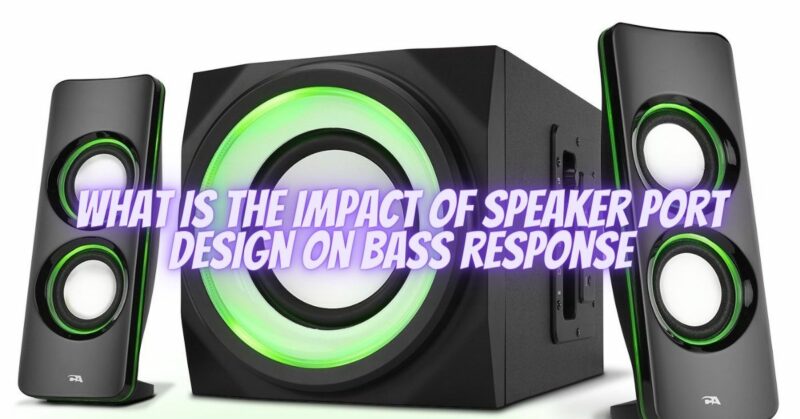The design of a speaker’s port, also known as a bass reflex or ported enclosure, plays a significant role in shaping the bass response of a speaker system. The port is a specifically engineered opening or tube in the speaker cabinet that interacts with the internal air volume to enhance low-frequency output. In this article, we will explore the impact of speaker port design on bass response, examining how different port characteristics can affect the overall sound quality, extension, and efficiency of the low-frequency reproduction.
- Bass Reflex Principle:
The bass reflex design in speakers employs a port to reinforce the low-frequency output by utilizing the air mass and resonance. The port acts as a conduit, allowing air to move in and out of the cabinet, augmenting the sound generated by the woofer. By carefully designing the port and its characteristics, the speaker’s low-frequency response can be optimized.
- Port Size and Length:
The size and length of the port significantly influence the tuning frequency and bass response of a speaker system:
a. Port Size: A larger port size generally allows for greater airflow, resulting in increased efficiency and potential for deeper bass extension. However, excessively large ports can introduce port noise or chuffing, where turbulent airflow causes unwanted audible artifacts. It is crucial to strike a balance between port size, cabinet volume, and desired bass response.
b. Port Length: The length of the port determines the tuning frequency or the point at which the bass output starts to roll off. A longer port can lower the tuning frequency, resulting in deeper bass response. Conversely, a shorter port raises the tuning frequency, providing a tighter and more controlled bass reproduction. Finding the optimal port length depends on the desired bass extension and the characteristics of the woofer used.
- Port Shape and Design:
The shape and design of the port can also impact the bass response and overall sound quality:
a. Circular vs. Rectangular Ports: Circular ports are commonly used due to their simplicity and effectiveness in minimizing port noise. However, rectangular ports can offer certain advantages in terms of airflow and tuning flexibility, especially in compact or slim speaker designs.
b. Flared Ports: Flaring the ends of the port can help reduce turbulence and minimize port noise, resulting in smoother airflow and cleaner bass reproduction. Flared ports can enhance low-frequency performance by reducing audible artifacts caused by excessive air movement.
c. Internal Port Design: The internal structure and design of the port, such as flanges or tubes, can influence airflow and minimize port resonances. These internal features can help optimize the port’s performance and reduce the potential for unwanted noise or distortion.
- Cabinet Placement and Boundary Effects:
The placement of the speaker cabinet can also impact the bass response due to boundary effects:
a. Proximity to Walls: Placing a ported speaker too close to walls or corners can enhance bass response due to the boundary reinforcement effect. This proximity increases the perceived bass output, but it can result in uneven bass response or excessive boominess. Experiment with speaker placement to find the optimal balance between boundary reinforcement and overall sound quality.
b. Baffle Step Compensation: Some ported speakers incorporate baffle step compensation circuits to address the inherent bass roll-off that occurs when sound radiates from a baffle into a 360-degree soundfield. This compensation circuitry helps maintain a balanced frequency response and consistent bass performance across different listening positions.
- Speaker and Port Integration:
The design of the speaker driver, particularly the woofer, should be compatible and properly integrated with the port design. The woofer’s characteristics, such as cone material, excursion capability, and power handling, should align with the port’s tuning frequency to achieve optimal bass response and avoid potential distortions or resonances.
Conclusion:
The design of the speaker port in a bass reflex system has a significant impact on the bass response of a speaker. The size, length, shape, and internal design of the port, along with the cabinet placement, influence the low-frequency extension, efficiency, and overall sound quality. By carefully engineering and tuning the port, speaker designers can optimize the bass performance, achieving deep, accurate, and well-controlled bass reproduction. When selecting a speaker, it is important to consider the port design and its compatibility with the woofer to ensure that the bass response aligns with your listening preferences and the intended listening environment.


